What Are Actinides?
The actinides is the collective name given to elements 90-103 in the periodic table, comprising thorium, protactinium, uranium, neptunium, plutonium, americium, curium, berkelium, californium, einsteinium, fermium, mendelevium, nobelium and lawrencium. The element actinium, atomic number 89, after which the group is named, is not — strictly speaking — itself one of the actinides, but is often included with them. As with all elements heavier than lead, none of the actinide series have any stable isotopes and all are therefore radioactive, generally undergoing alpha decay into other elements. Uranium and thorium occur naturally, along with traces of actinium, protactinium, plutonium and neptunium. The remaining elements have never been observed in nature, but have been manufactured in extremely small quantities in particle accelerators.
Uranium and thorium have long half-lives and have been present in the Earth in significant quantities since its formation. It is thought that much of the heat in the Earth’s core, which drives plate tectonics and volcanism, is due to the radioactive decay of these elements. The isotope plutonium-244 has a relatively long half-life and traces of the Earth’s original plutonium still survive; however, most plutonium in the environment comes from nuclear reactors and nuclear weapons tests. Naturally occurring actinium, protactinium, and neptunium have much shorter half-lives, so any quantities of these elements which were present when the Earth was formed would long ago have decayed into other elements. Actinium, protactinium and neptunium form through nuclear processes associated with the decay of isotopes of uranium.

Like the lanthanide elements, the actinides occupy a separate block from the main periodic table, as it is usually depicted, because of their electron configurations. In both of these blocks, the outermost electron subshell has been occupied before a prior subshell, due to the latter having a higher energy level, and it is the number of electrons in this subshell that differentiates the elements from one another. For the lanthanides, it is the 4f subshell that is important, and for the actinides, the 5f subshell. These elements are also known as the f-block elements. The outermost subshell is the same for all the elements within each block, except for lawrencium, which differs from the preceding element not in the 5f subshell, but in having an additional 7p subshell containing one electron.

Actinide chemistry is governed by the fact that the valence electrons, which can bond with other atoms, are not confined to the outermost subshell, giving a variable number of oxidation states among these elements. For example, plutonium can have oxidation states from +3 to +7. All of the elements are chemically reactive, and rapidly oxidize in air, becoming coated with a layer of oxide. Reactivity increases with atomic weight within the group; however, investigation of the chemical properties of some of the heavier members is difficult because of their intense radioactivity and very short half-lives.
The longer-lived actinide isotopes have found a variety of uses. Thorium has been used since the late 19th century in the production of gas mantles. The ability of some isotopes of uranium and plutonium to undergo nuclear fission has led to their use in nuclear reactors and nuclear weapons, and plutonium has also been used as a long-lasting power source for space probes. Americium is used in smoke detectors.
AS FEATURED ON:
AS FEATURED ON:












Discuss this Article
Post your comments